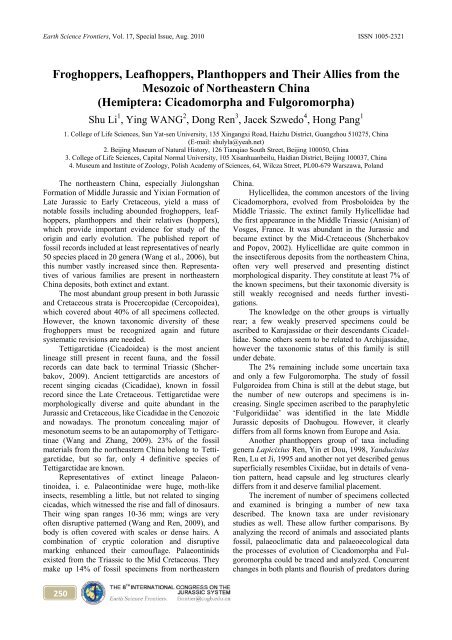in Jurassic and Cretaceous Stratigraphy
in Jurassic and Cretaceous Stratigraphy
in Jurassic and Cretaceous Stratigraphy
You also want an ePaper? Increase the reach of your titles
YUMPU automatically turns print PDFs into web optimized ePapers that Google loves.
Earth Science Frontiers, Vol. 17, Special Issue, Aug. 2010 ISSN 1005-2321<br />
Froghoppers, Leafhoppers, Planthoppers <strong>and</strong> Their Allies from the<br />
Mesozoic of Northeastern Ch<strong>in</strong>a<br />
(Hemiptera: Cicadomorpha <strong>and</strong> Fulgoromorpha)<br />
250<br />
Shu Li 1 , Y<strong>in</strong>g WANG 2 , Dong Ren 3 , Jacek Szwedo 4 , Hong Pang 1<br />
1. College of Life Sciences, Sun Yat-sen University, 135 X<strong>in</strong>gangxi Road, Haizhu District, Guangzhou 510275, Ch<strong>in</strong>a<br />
(E-mail: shulyla@yeah.net)<br />
2. Beij<strong>in</strong>g Museum of Natural History, 126 Tianqiao South Street, Beij<strong>in</strong>g 100050, Ch<strong>in</strong>a<br />
3. College of Life Sciences, Capital Normal University, 105 Xisanhuanbeilu, Haidian District, Beij<strong>in</strong>g 100037, Ch<strong>in</strong>a<br />
4. Museum <strong>and</strong> Institute of Zoology, Polish Academy of Sciences, 64, Wilcza Street, PL00-679 Warszawa, Pol<strong>and</strong><br />
The northeastern Ch<strong>in</strong>a, especially Jiulongshan<br />
Formation of Middle <strong>Jurassic</strong> <strong>and</strong> Yixian Formation of<br />
Late <strong>Jurassic</strong> to Early <strong>Cretaceous</strong>, yield a mass of<br />
notable fossils <strong>in</strong>clud<strong>in</strong>g abounded froghoppers, leaf-<br />
hoppers, planthoppers <strong>and</strong> their relatives (hoppers),<br />
which provide important evidence for study of the<br />
orig<strong>in</strong> <strong>and</strong> early evolution. The published report of<br />
fossil records <strong>in</strong>cluded at least representatives of nearly<br />
50 species placed <strong>in</strong> 20 genera (Wang et al., 2006), but<br />
this number vastly <strong>in</strong>creased s<strong>in</strong>ce then. Representa-<br />
tives of various families are present <strong>in</strong> northeastern<br />
Ch<strong>in</strong>a deposits, both ext<strong>in</strong>ct <strong>and</strong> extant.<br />
The most abundant group present <strong>in</strong> both <strong>Jurassic</strong><br />
<strong>and</strong> <strong>Cretaceous</strong> strata is Procercopidae (Cercopoidea),<br />
which covered about 40% of all specimens collected.<br />
However, the known taxonomic diversity of these<br />
froghoppers must be recognized aga<strong>in</strong> <strong>and</strong> future<br />
systematic revisions are needed.<br />
Tettigarctidae (Cicadoidea) is the most ancient<br />
l<strong>in</strong>eage still present <strong>in</strong> recent fauna, <strong>and</strong> the fossil<br />
records can date back to term<strong>in</strong>al Triassic (Shcher-<br />
bakov, 2009). Ancient tettigarctids are ancestors of<br />
recent s<strong>in</strong>g<strong>in</strong>g cicadas (Cicadidae), known <strong>in</strong> fossil<br />
record s<strong>in</strong>ce the Late <strong>Cretaceous</strong>. Tettigarctidae were<br />
morphologically diverse <strong>and</strong> quite abundant <strong>in</strong> the<br />
<strong>Jurassic</strong> <strong>and</strong> <strong>Cretaceous</strong>, like Cicadidae <strong>in</strong> the Cenozoic<br />
<strong>and</strong> nowadays. The pronotum conceal<strong>in</strong>g major of<br />
mesonotum seems to be an autapomorphy of Tettigarc-<br />
t<strong>in</strong>ae (Wang <strong>and</strong> Zhang, 2009). 23% of the fossil<br />
materials from the northeastern Ch<strong>in</strong>a belong to Tetti-<br />
garctidae, but so far, only 4 def<strong>in</strong>itive species of<br />
Tettigarctidae are known.<br />
Representatives of ext<strong>in</strong>ct l<strong>in</strong>eage Palaeon-<br />
t<strong>in</strong>oidea, i. e. Palaeont<strong>in</strong>idae were huge, moth-like<br />
<strong>in</strong>sects, resembl<strong>in</strong>g a little, but not related to s<strong>in</strong>g<strong>in</strong>g<br />
cicadas, which witnessed the rise <strong>and</strong> fall of d<strong>in</strong>osaurs.<br />
Their w<strong>in</strong>g span ranges 10-36 mm; w<strong>in</strong>gs are very<br />
often disruptive patterned (Wang <strong>and</strong> Ren, 2009), <strong>and</strong><br />
body is often covered with scales or dense hairs. A<br />
comb<strong>in</strong>ation of cryptic coloration <strong>and</strong> disruptive<br />
mark<strong>in</strong>g enhanced their camouflage. Palaeont<strong>in</strong>ids<br />
existed from the Triassic to the Mid <strong>Cretaceous</strong>. They<br />
make up 14% of fossil specimens from northeastern<br />
Ch<strong>in</strong>a.<br />
Hylicellidea, the common ancestors of the liv<strong>in</strong>g<br />
Cicadomorphora, evolved from Prosboloidea by the<br />
Middle Triassic. The ext<strong>in</strong>ct family Hylicellidae had<br />
the first appearance <strong>in</strong> the Middle Triassic (Anisian) of<br />
Vosges, France. It was abundant <strong>in</strong> the <strong>Jurassic</strong> <strong>and</strong><br />
became ext<strong>in</strong>ct by the Mid-<strong>Cretaceous</strong> (Shcherbakov<br />
<strong>and</strong> Popov, 2002). Hylicellidae are quite common <strong>in</strong><br />
the <strong>in</strong>sectiferous deposits from the northeastern Ch<strong>in</strong>a,<br />
often very well preserved <strong>and</strong> present<strong>in</strong>g dist<strong>in</strong>ct<br />
morphological disparity. They constitute at least 7% of<br />
the known specimens, but their taxonomic diversity is<br />
still weakly recognised <strong>and</strong> needs further <strong>in</strong>vesti-<br />
gations.<br />
The knowledge on the other groups is virtually<br />
rear; a few weakly preserved specimens could be<br />
ascribed to Karajassidae or their descendants Cicadel-<br />
lidae. Some others seem to be related to Archijassidae,<br />
however the taxonomic status of this family is still<br />
under debate.<br />
The 2% rema<strong>in</strong><strong>in</strong>g <strong>in</strong>clude some uncerta<strong>in</strong> taxa<br />
<strong>and</strong> only a few Fulgoromorpha. The study of fossil<br />
Fulgoroidea from Ch<strong>in</strong>a is still at the debut stage, but<br />
the number of new outcrops <strong>and</strong> specimens is <strong>in</strong>-<br />
creas<strong>in</strong>g. S<strong>in</strong>gle specimen ascribed to the paraphyletic<br />
‘Fulgoridiidae’ was identified <strong>in</strong> the late Middle<br />
<strong>Jurassic</strong> deposits of Daohugou. However, it clearly<br />
differs from all forms known from Europe <strong>and</strong> Asia.<br />
Another phanthoppers group of taxa <strong>in</strong>clud<strong>in</strong>g<br />
genera Lapicixius Ren, Y<strong>in</strong> et Dou, 1998, Y<strong>and</strong>ucixius<br />
Ren, Lu et Ji, 1995 <strong>and</strong> another not yet described genus<br />
superficially resembles Cixiidae, but <strong>in</strong> details of vena-<br />
tion pattern, head capsule <strong>and</strong> leg structures clearly<br />
differs from it <strong>and</strong> deserve familial placement.<br />
The <strong>in</strong>crement of number of specimens collected<br />
<strong>and</strong> exam<strong>in</strong>ed is br<strong>in</strong>g<strong>in</strong>g a number of new taxa<br />
described. The known taxa are under revisionary<br />
studies as well. These allow further comparisons. By<br />
analyz<strong>in</strong>g the record of animals <strong>and</strong> associated plants<br />
fossil, palaeoclimatic data <strong>and</strong> palaeoecological data<br />
the processes of evolution of Cicadomorpha <strong>and</strong> Ful-<br />
goromorpha could be traced <strong>and</strong> analyzed. Concurrent<br />
changes <strong>in</strong> both plants <strong>and</strong> flourish of predators dur<strong>in</strong>g

















